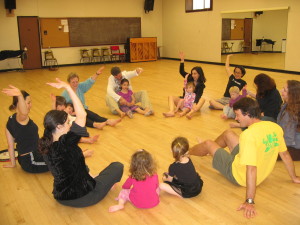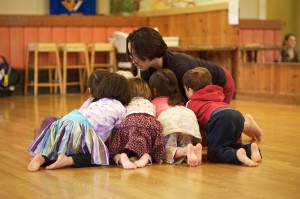“When I’m taking dance class, I just feel so able. I feel like my body can do anything; like I’m Wonder Woman or something.”
“Dancing meant so much to me and helped my self-confidence. It is a place where I can express myself and be free…”
“Dance has made me change my life and experience what life is about through dancing.”
“When I see young children dancing…they are also laughing. They are expanding their sense of self and each other. Maybe that’s the beginning of school and social transformation.”
These are a few quotes from children and teachers who have experienced and witnessed the infinite possibilities dance brings to a right livelihood. What is a right livelihood? There are many definitions. Here are some definitions I found when I Googled the term: “As a way of working and as a way of thinking about work, right livelihood embodies its own psychology—a psychology of a person moving toward the fullest participation in life, a person growing in self-awareness, trust and self-esteem. Abraham Maslow. . . calls it ‘self-actualizing’. The phrase simply means growing whole.”1 From the Buddhist Centre website, “Right livelihood is an important aspect of the Buddha’s Noble Eightfold Path. The Buddha encouraged his disciples to make their living in a way that does not cause harm and ideally that is ethically positive.” The site continues to delve into ideas such as, “How can work become meaningful? How can it be a support not a hindrance to spiritual practice—a place to deepen our awareness and kindness?”2

When I am dancing, when I am making dances, when I am teaching dance, dance meets both these definitions of right livelihood. On Sunday mornings, I religiously take a West African dance class; this is my church. Even when I have to drag myself out of bed and forego a second cup of coffee I always feel better after the class, more balanced and “whole” to start the week. I am energized and leave class with a sense of purpose toward the week ahead. I imagine these are some of the feelings imparted to the children and families I teach, and to the teaching artists I mentor and coach.
Luna was founded 22 years ago by my colleague Patricia Reedy in response to the closing of Citi Centre Dance Theatre (part of what is now Malonga Casquelourd Center for the Arts) due to the Loma Prieta earthquake. Reedy and other Citi Centre dancers had a place to teach and continue their livelihood, and meet the community’s need for a place to dance. At the studio’s heart and vision was an integrated laboratory for the artistic and teaching work of chorographers and dancers. Early on we were interested in exploring the multiples roles artists play in their communities and how these roles intersect with audience participation and youth and family engagement in the dance arts. We explored back then and we continue to investigate the dancer’s many roles as choreographer, teacher, grass-roots organizer, leader, activist, change agent.
As a young teaching artist, 20+ years ago at the Luna studio I could make a right livelihood for myself and also share this with a community of fellow creators, students and audience members. Now, as one of Luna’s co-directors I view right livelihood in new ways generating more questions than I currently have answers for: What does this mean in my current position as an arts education leader, where the purity of the art form takes a back seat to common core standards and arts integration? How do I balance being a non-profit leader with integrity and stand-up for what I know to be true for children and the art form of dance? How do I hold our staff and myself accountable to our mission and values? How does the choreographer part of my self (the self that sees things from various perspectives, is flexible, innovative, a risk-taker, a multi-tasker and playful) influence my interactions with the world and the communities we serve? I am interested in articulating how as dancers we support right livelihood for ourselves, but also for others, and shouting from the mountain tops how integral we are to the health and well-being of our communities.
Despite the ephemeral nature of dance, it leaves an imprint that is lasting. There is something about embodying a fleeting idea, a random thought, an urge, an anticipation that is deeply gratifying and liberating at the same time. Dance gives human beings the opportunity to truly be in the moment and to experience the concrete. Yes, dance supports 21st century learning skills—collaboration, problem-solving, creativity, flexibility, but when one is dancing there is so much more! Neuro-science research is exploring how the act of dancing and viewing dance supports empathy through the mirror-neuron process. Kimerer LaMothe, in a Psychology Today article suggests that humans need to execute a movement so that we can be empathetic when viewing a movement. She further suggests that the practice of creating new movements while interacting with another person through dance and play supports our capacity to move and relate to each other.3 Luna has found similar results from research in our MPACT (Moving Parents and Children Together) program where during a series of dance classes, families demonstrated positive growth in, and increasing self-awareness of, interpersonal attitudes and behaviors.4 LaMothe poses the thesis that humans evolved as moving and dancing beings in order to survive.Karen Kohn Bradley’s recently published research in Frontiers in Human Neuroscience used the Laban Effort Actions to decode human expressive movement. This research suggests there are applications for the neural basis of expressive movements and the development of neuroprosthetics to restore movement.5

As dancers, we know the world through moving and creating in our bodies. This way of “knowing” and then “thinking” about the world seeps into the multi-faceted roles we play in our community. We use our bodily intelligence to not only make dances, but also to investigate and change our world. We do this as researchers delving into the complexities of the brain and dance; as educators nurturing students to become their most complete self—body, mind and soul; as thought-leaders who generate innovative ideas and are willing to take a risk. At Luna, all ofour teachers are dance-makers. Their practice in dance-making informs their teaching and visa versa. Our dance presenting events, CHOREOFUND and 20 Points of View connect parents, and students and general audience members to the process of dance-making. Students learning to choreograph, and parentswho are beginning to understand what choreography is, can see how the dances of the working artist inform the dance-making that is happening in a Luna class. Giving parents an opportunity to see choreographers in action and relate this to their own child’s learning is one way to articulate the dancer’s role in community. Making dance visible through social media, posting articles on the parent bulletin board, talking about dance to the person next to me on the airplane are other ways. Yet, I wish there was an opportunity to demonstrate a dancer’s role in the community en masse.
In May, I was at a statewide teaching artist meeting where the executive director of iCan, a visual arts organization in Santa Barbara shared one-minute short videos poignantly demonstrating the value of the arts in children’s lives. These videos were being broadcast as previews in all the Santa Barbara movie houses before each movie. The videos were tearjerkers, clearly professionally done and the iCAN director was able through his connections to negotiate a very reasonable advertising rate to have these previews screened for a month. What if we could to something like this for dance, profiling the dancer’s diverse contributions in our society? There could be dancers featured as educators, therapists, scientists and leaders. What if this could be screened nationwide for a month in every movie house? Would this leave an imprint? Would this shift perception enough to encourage the public to widen the perception of the dancer’s role in society beyond entertainment?
Right livelihood through dance will continue to be a road of inquiry for me as I live through what I hope will be the next 40+ years. After all, I have role models like Anna Halprin and Ann Hutchinson Guest to look up to. There is something about being middle-aged that is driving me toward a renewed purpose in my identity as a dancer. Hopefully, I will be able to answer at least half the questions posed in this article, and do this with the grace, integrity, dignity and stamina that our elder dance change-makers have inspired.
Footnotes:
1. paigedoughty.com/2008/04/17/what-is-right-livelihood/
2. thebuddhistcentre.com/text/right-livelihood
3. LaMothe, Kimerer. “Did humans evolve to Dance (4)? Movement and mirror neurons.” Psychology Today, sussex publishers LLc, 31 July 2013. Web. 2 June 2014.
4. Warburton, e., reedy, p., & ng, n. (2014). “engaging families in dance: an investigation of moving parents and children together.” International Journal of Education & the Arts, 15(1). retrieved from ijea.org/v15n1/.
5. cruz-Garza JG, hernandez Zr, nepaul s, Bradley KK and contreras-vidal JL (2014) neural decoding of expressive human movement from scalp electroencephalography (eeG). Front. Hum. Neurosci. 8:188. doi: 10.3389/ fnhum.2014.00188
This article appeared in the Jul/Aug 2014 issue of In Dance.

